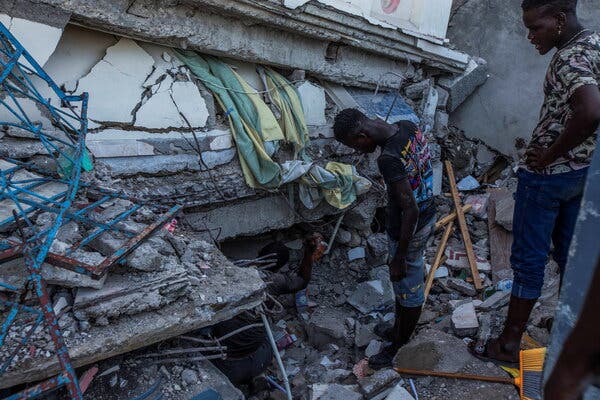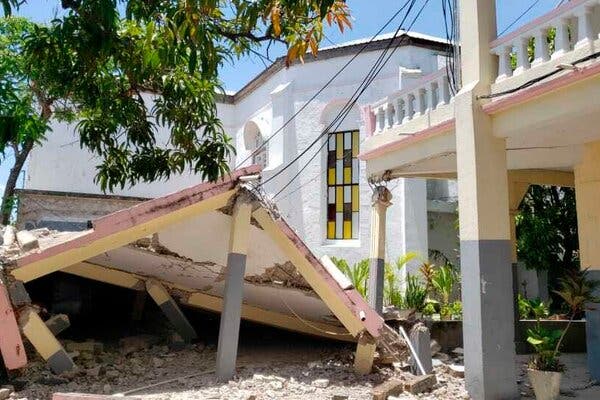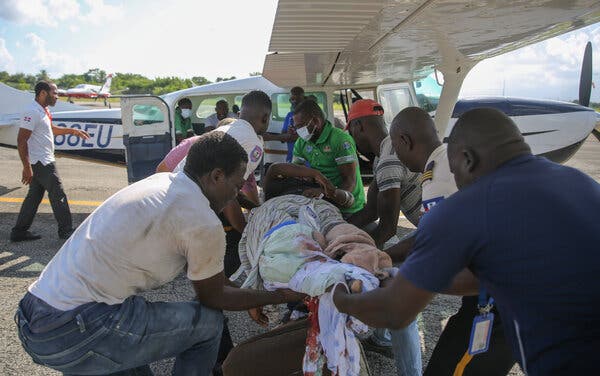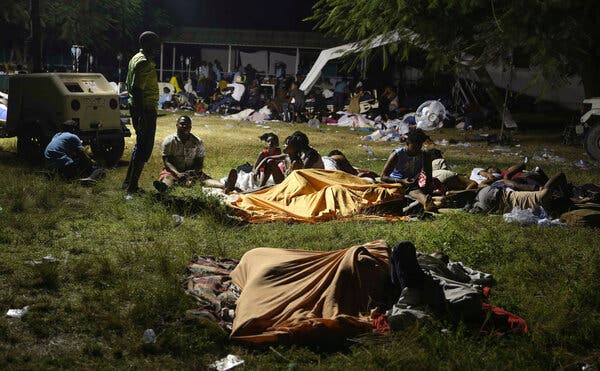Haiti Live Updates: Search for Survivors After Quake Kills More Than 700
The 7.2 earthquake was a devastating blow to a country still reeling from a presidential assassination. The leadership vacuum has hampered aid and rescue efforts.
Here’s what you need to know:
- More than 700 dead after Haiti earthquake as country braces for Tropical Storm Grace.
- Here is what to know about the Haiti earthquake.
- In photos: destruction and despair in Haiti after earthquake.
- One surgeon is treating the wounded in a makeshift operating room at the airport.
- Haiti scrambles to coordinate aid response after devastating earthquake.
- The latest Haiti earthquake was more powerful than the devastating quake in 2010.
- Tropical Storm Grace heads toward quake-ravaged Haiti.
More than 700 dead after Haiti earthquake as country braces for Tropical Storm Grace.

Looking for survivors at a house that was damaged in an earthquake in Les Cayes, Haiti, on Saturday.Credit…Ralph Tedy Erol/Reuters
LES CAYES, Haiti — Haitians struggled with a lack of basic supplies, including food and medical care, in the aftermath of a magnitude 7.2 earthquake on Saturday that snapped water lines, blocked roads, flattened grocery stores and damaged hospitals on the country’s southwestern peninsula.
The powerful earthquake was a devastating blow to a country that is still reeling from a presidential assassination last month and that never recovered from a disastrous quake more than 11 years ago. Aid groups and government rescue workers established a single operation center in Port-au-Prince to coordinate the quake response, but many in the hard hit town of Les Cayes were loading injured into cars and on to private planes to try to evacuate them to the capital, Port-au-Prince, for care.
Herve Foucand, a former senator, was using his small propeller plane to ferry people to Haiti’s capital.
“I have 30 people in serious condition waiting for me,” he said. “But I only have seven seats.”
Small towns surrounding Les Cayes were cut off by landslides and are believed to be even harder hit.
To complicate the chaotic efforts even more, Tropical Storm Grace was expected to pass over Haiti on Monday, although forecasters said it might spare the peninsula hardest hit by the quake.
The confirmed death toll rose to 724 on Sunday and at least 2,800 people have been injured, Jerry Chandler, head of Haiti’s Civil Protection Agency, said at a news conference.
Mr. Chandler said that heavy damage had been reported in the cities of Jérémie and Les Cayes, an area that is less densely populated but also more remote. Thousands of homes and a multistory hotel collapsed, and some roads and bridges were impassable, complicating rescue and aid efforts. Still, Mr. Chandler promised a “more appropriate response than the one we gave in 2010,” when millions in aid seemed to vanish amid a cloud of corruption and confusion.
Prime Minister Ariel Henry said: “These are difficult times. Let’s forget our quarrels. Let’s forget about anything else — let’s help the poorest and most needy people.”
The recovery was being conducted in the throes of a political crisis that followed President Jovenel Moïse’s assassination on July 7. The unsolved assassination, a leadership vacuum, severe poverty and systemic gang violence in parts of Haiti, a Caribbean nation of 11 million people, have left the government dysfunctional and ill prepared for a natural calamity.
Humanitarian aid was immediately promised by the United States and other countries, the United Nations and private organizations. By Saturday night, the gangs that control the highway linking the southern peninsula to the rest of Haiti declared a truce for humanitarian reasons, allowing aid to flow to devastated areas and alleviating concerns that trucks delivering the supplies would be held up and looted.
— Maria Abi-Habib
Here is what to know about the Haiti earthquake.

The Sacred Heart church in Les Cayes was damaged in an earthquake on Saturday.Credit…Delot Jean/Associated Press
What happened?
An earthquake of 7.2. magnitude struck Haiti on Saturday morning. It was stronger than the 7.0-magnitude earthquake that devastated the Caribbean country in 2010. The United States Geological Survey said the quake struck five miles from the town of Petit Trou de Nippes in the western part of the country, about 80 miles west of Port-au-Prince, the capital. Seismologists said it had a depth of seven miles. It was felt as far away as Jamaica, 200 miles away.
The U.S. Tsunami Warning Center reported a tsunami threat because of Saturday’s earthquake, but later rescinded it.
Aftershocks have rippled through the region, the U.S.G.S. said.
What is the death toll?
Jerry Chandler, head of Haiti’s Civil Protection Agency, said Sunday during a news conference that at least 724 people had been confirmed dead.
Among the dead was the former mayor of Les Cayes, Gabriel Fortuné, who was killed when the hotel he owned collapsed during the quake, according to a local journalist who knew him, Jude Bonhomme.
What parts of Haiti were affected?
Two cities, Les Cayes and Jeremie, located in Haiti’s southern peninsula, have reported major devastation with people caught under rubble and buildings collapsed. Phone lines were down in Petit Trou de Nippes, the epicenter of the quake. No news emerged immediately from that city, leaving Haitian officials to fear for the worst.
The full extent of the damage and casualties is not yet known. But doctors said hospitals were overwhelmed.
A building housing medical students, hospital interns and two doctors had collapsed, trapping those who were most needed to provide aid, said Dr. James Pierre, a surgeon at the general hospital of Les Cayes, also known as the Hospital Immaculée Conception.
The State Department’s internal assessment of the earthquake was bleak. Up to 650,000 people experienced “very strong” tremors with an additional 850,000 affected by “strong shaking,” leaving thousands of buildings at risk of damage and possible collapse, according to the assessment, shared by a State Department official.
What does this mean for the country?
This earthquake could not have come at a worst time for Haiti, which never recovered from the 2010 earthquake that killed some 300,000 people and leveled much of Port-au-Prince. The southern peninsula, where the earthquake hit, is also still recovering from Hurricane Matthew, which hit the country in 2016.
The country of 11 million is also recovering from political turmoil. Haiti has been in the throes of a political crisis since President Jovenel Moïse was assassinated on July 7, and the government is not financially equipped to take care of repairs.
— Isabella Grullón Paz
Advertisement
Continue reading the main story
In photos: destruction and despair in Haiti after earthquake.
[list=s-carousel__kebob]
[*]slide 1
[*]slide 2
[*]slide 3
[*]slide 4
[*]slide 5
[*]slide 6
[*]slide 7
[/list]
Scenes of destruction in the earthquake-devastated town of Les Cayes on Sunday as officials raised the death toll to more than 700. Hotels and houses crumbled, and people were forced to sleep on the streets and in soccer fields. Small towns surrounding Les Cayes were cut off by landslides and are believed to be even harder hit.
— The New York Times
One surgeon is treating the wounded in a makeshift operating room at the airport.

An injured woman is taken to a plane to be flown to Port-au-Prince from Les Cayes, Haiti, on Saturday.Credit…Joseph Odelyn/Associated Press
LES CAYES, Haiti — A day after a magnitude 7.2 earthquake ripped through western Haiti — killing 724 people — the main airport of the city of Les Cayes was overwhelmed with Haitians trying to evacuate their loved ones to the capital, Port-au-Prince. The needs of the wounded were too huge for local hospitals and doctors to handle.
Herve Foucand, a former senator from the southern region of the country, was using his small propeller plane to transport the injured.
“I have 30 people in serious condition waiting for me,” Mr. Foucand said. “But I only have seven seats.”
“The hospitals are broken inside,” Mr. Foucand added, saying he had used his tiny plane to personally evacuate 50 people to the capital since Saturday.
The earthquake was just the latest disaster to strike Haiti, which is still coping with the devastation from a 2010 quake that killed 300,000 people. Saturday’s quake came barely a month after the country’s president, Jovenel Moïse, was assassinated in his bedroom, plunging the country into a political crisis even as it was struggling with years of severe poverty and systemic gang violence.
Officials in Les Cayes believe there are no more than 30 doctors in the entire southern region, home to roughly one million people. All the main hospitals are damaged. Doctors in Les Cayes worked overnight to build a temporary operating room — made of corrugated tin — near the airport.
An orthopedic surgeon, Edward Destine, was tending to the injured there. “I’m the only surgeon,” he said.
“I would like to operate on 10 people today, but I just don’t have the supplies,” he added, saying he needed intravenous drips and antibiotics.
Many of the wounds were fractures, Dr. Destine said, including dangerous head and femur fractures.
Because the wounds were open and many people were living in damaged homes or out on the streets, he expected thousands to suffer from potentially fatal infections.
“We can’t even do lab tests,” he added.
Dr. Destine’s own father, also a surgeon, had suffered major head trauma during the quake when part of a roof fell on him. He was hoping to get him evacuated to Port-au-Prince.
Palmera Claudius, 30, lay in the bed of a pickup truck her relatives had hired to take her to the airport. The left side of her face was swollen, and her left arm was in a makeshift sling made from a torn blue shirt.
She was in her family home in Camp Perrine, on the outskirts of Les Cayes, when she felt her whole house jolt on Saturday. As she tried to run outside for safety, a wall collapsed on her.
She cannot feel her legs, she said. The local clinic in her town does not have the capacity to X-ray her. She was hoping to catch a flight to the capital as soon as one was available and willing to take her for free. Her family has no money to pay the cost.
— Maria Abi-Habib
Advertisement
Continue reading the main story
Haiti scrambles to coordinate aid response after devastating earthquake.

Displaced from their destroyed houses by an earthquake, people spent the night outdoors in the hospital garden in Les Cayes, Haiti, on Saturday.Credit…Joseph Odelyn/Associated Press
The authorities in Haiti were scrambling to coordinate their response to the 7.2 magnitude earthquake on Saturday, mindful of the confusion that followed a devastating quake in 2010, when delays in distributing aid to hundreds of thousands of people worsened the death toll.
“We learned from the 2010 earthquake,” Prime Minister Ariel Henry said at a news conference on Saturday, adding that to facilitate coordination, all aid would go through a single operation center in Port-au-Prince.
In a statement, Paul Farmer, a physician and co-founder of the relief agency Partners in Health, who has long worked in Haiti, said the hospitals that it oversees had largely improved their emergency capacities and protocols in the past decade.
“They can do more, and faster, than back then, and will be counting on all of us for the pragmatic solidarity they deserve,” Mr. Farmer wrote.
More than 700 people have been confirmed killed in the country’s southwest, according to the latest figures provided by Haiti’s Civil Protection Agency, while an untold number were missing, raising fears that they have been trapped under piles of concrete slabs from buildings flattened by the earthquake.
The agency added that hundreds of homes had been destroyed and damaged, as well as many health centers, schools, offices and churches.
“The most important thing is to recover as many survivors as possible under the rubble,” Mr. Henry, who declared a one-month state of emergency, said on Saturday, according to The Associated Press.
“The needs are enormous. We must take care of the injured and fractured, but also provide food, aid, temporary shelter and psychological support,” he added.
Several hospitals in unaffected areas quickly provided assistance, responding to calls for solidarity that proliferated on social networks.
The State University of Haiti Hospital, based in the capital of Port-au-Prince, sent doctors to the southwest while the relief agency Zanmi Lasante, which runs several hospitals and works with Partners in Health, said on Twitter that it was working with its partners, preparing for an influx of patients.
On Saturday, the country’s ministry of public health said in a message posted on Facebook that it was “in urgent need of blood for the victims” and called on people to donate blood, to prevent a shortage because so many people are expected to need treatment.
In 2010, the earthquake destroyed the National Blood Transfusion Center in Port-au-Prince, leaving the country in dire need of blood bags, which delayed surgeries and caused more deaths and amputations.
Since then, according to a 2016 study, Haiti has scaled up its blood drives, exceeding pre-earthquake levels as soon as 2012 and increasing regional collections in order to reduce dependence on Port-au-Prince.
Sending the much needed aid to the hardest hit sites, about 125 miles away, in the southwest of the country, will be a challenge in itself. Gang activity around Port-au-Prince has made traveling on the roads dangerous, and possible flooding and damage from Tropical Storm Grace, expected to hit Haiti on Monday, could complicate relief efforts.
On Saturday, gangs that control the highway linking the southern peninsula to the rest of Haiti declared a truce for humanitarian reasons, allowing aid to flow to devastated areas.
Mr. Henry said that police forces and other means were “mobilized so that this aid that we want to send to our brothers and sisters in difficulty can arrive.”
— Milo Milfort contributed to this story from Port-au-Prince.
— Constant Méheut
The latest Haiti earthquake was more powerful than the devastating quake in 2010.

A satellite image showing the Enriquillo-Plantain Garden fault zone in Haiti in 2010.Credit…NASA
The earthquake that struck Haiti on Saturday morning occurred on the same system of faults as the one that devastated the capital, Port-au-Prince, in January 2010. And the previous quake almost certainly made this one more likely to occur.
Both quakes struck on an east-west fault line at the convergence of two tectonic plates, large segments of the Earth’s crust that slowly move in relationship to each other. At this fault line, called the Enriquillo-Plantain Garden fault zone, the Caribbean plate and the North American plate move laterally, or side by side, at a rate of about a quarter of an inch a year.
The 2010 quake was centered about 30 miles west of Port-au-Prince. The quake on Saturday was about 50 miles further west.
Susan E. Hough, a seismologist with the United States Geological Survey who studied the 2010 earthquake, said there was no doubt that it and the one Saturday were linked.
“It’s well established that you do have this domino concept,” she said, where the energy released by one earthquake alters the stress patterns elsewhere along the fault line. “But we don’t have a crystal ball that tells us which domino is going to fall next.”
Dr. Hough said seismologists had been concerned about a region of the fault zone to the east, closer to the 2010 rupture site. “Now we’ve seen the segment to the west rupture,” she said.
She said that the fault ruptured both vertically and laterally. Preliminary analyses suggested that the fault ruptured to the west, which would mean that most of the energy was directed away from Port-au-Prince and toward the more sparsely populated region along the Tiburon peninsula. If that’s the case, then most of the aftershocks that inevitably follow a large earthquake would most likely occur to the west as well.
“To the extent that anything could be good news for Haiti, those are good signs,” Dr. Hough said.
At a magnitude of 7.2, Saturday’s quake released about twice as much energy as the one in 2010, which was a magnitude-7.0 quake. That quake killed some 300,000 people. Jerry Chandler, head of Haiti’s Civil Protection Agency, said Sunday during a news conference that the latest earthquake had killed at least 724 people.
Damage and casualties from quakes depend on many factors besides magnitude. The depth and location of the rupture, the time it occurred and the quality of construction all can play major roles. In the 2010 earthquake, shoddy construction — especially poorly built masonry buildings — was blamed for many of the deaths and injuries.
The fault zone extends west to Jamaica, which is also at risk of major earthquakes. In addition to the 2010 quake, the fault zone was most likely the source of four major earthquakes in the 18th and 19th centuries, including ones that leveled Port-au-Prince in 1751 and again in 1770.
— Henry Fountain
https://www.nytimes.com/live/2021/08/15/world/haiti-earthquake
https://youtu.be/QWRb5OI6JgI
https://youtu.be/kfL5PiUDCCg
Related posts:
Views: 0
 RSS Feed
RSS Feed

















 August 16th, 2021
August 16th, 2021  Awake Goy
Awake Goy  Posted in
Posted in  Tags:
Tags: 
















